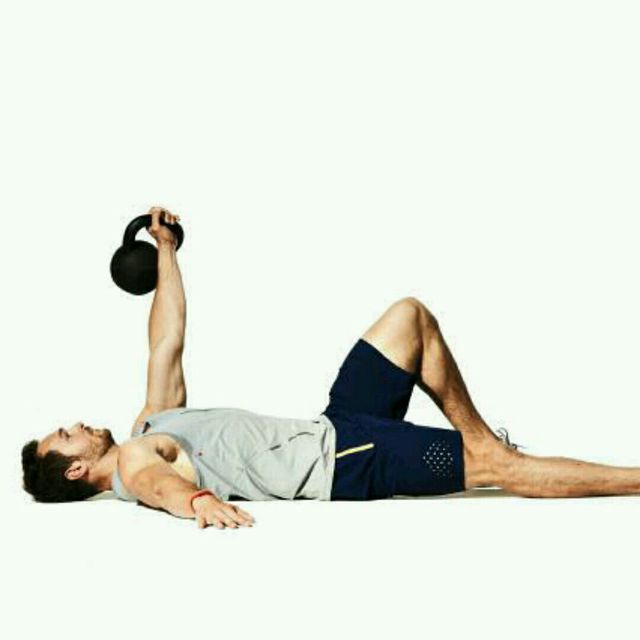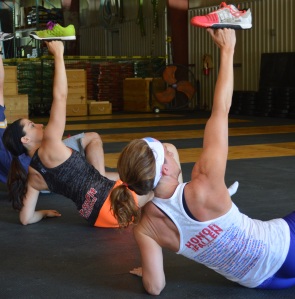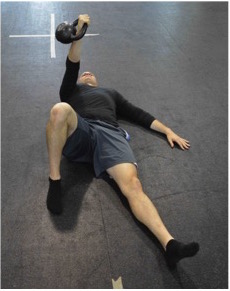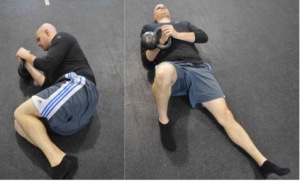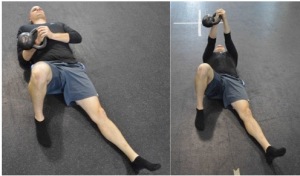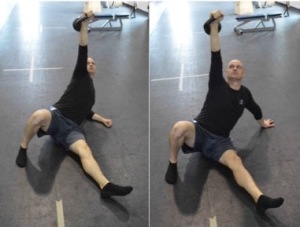The Turkish Get-Up is awesome and is the best exercise your are not doing. Legend claims It’s at least 200 years old and is thought to have been created for soldiers fighting with shields and swords as a means to get from their back to a standing position when an enemy was on top of them. While its history is impressive, its training impact on training and performance is even more significant. One of the most respected professionals in our industry, Gray Cook, said “The Turkish Get-Up is the perfect example of training primitive movement patterns-from rolling over, to kneeling, to standing and reaching. The Get-Up promotes the shoulders’ stability and mobility. It improves one’s strength in many patterns by teaching the importance of linkage while eliminating strength leakage.” We can’t forget, it also provides the opportunity to functionally evaluate the right and left sides.
While it is amazing one exercise can do all the above (and more), performing this exercise can be extremely challenging. This 3-part series will put you in a position to understand how to safely and effectively perform the Turkish Get-Up.
An ideal place to start is with your sneaker. Yes, that’s right… your sneaker. In lieu of a kettlebell, we recommend you begin this process by balancing a sneaker on your fist. We also recommend mastering the Half Get-Up before moving the to “full” Get-Up.
The Half Get-Up is separated into 5 steps:
1: Roll
2: Press
3: Drive up to the elbow
4: Post up onto your hand
5: High bridge
Here are step-by-step instructions:
Now it’s inevitable you will come across some issues along the way. Two very common issues to watch for are the knee on the kettlebell side collapsing inward at the initiation of the drive to the elbow and high bridge as well as shoulder positioning issues.
Here’s one strategy to fix a collapsing knee on the kettlebell side:
Here’s a great drill to use to help with shoulder positioning on the kettlebell side:
Additional key item to address:
I. What to do with your head and eyes:
It’s important to look at the kettlebell through the entire half get up. However, you should begin to teach this when practicing with a sneaker. If you think about it… there is a heavy piece of iron over your head. Given the fact that you are actively moving your body beneath it, it is a really good idea to keep your focus on the kettlebell. Safety is a real concern here, especially when venturing towards “heavy” kettlebells. We’ll go over spotting in our next post.
II. Setting up after the press
Get very, very familiar with this position if you are going to perform and/or coach get ups. Setting up correctly after the press sets the stage for the rest of the get up. If your limbs aren’t correctly aligned you might not have the leverage you’ll need to successfully perform a Get-Up. This could mean a failed attempt OR losing the kettlebell and ending up with a serious injury to your cranium.
Notice these key points:
- The arm on the kettlebell side is straight (elbow and wrist), the shoulder is packed, and the fist is directly above the shoulder joint.
- The leg on the kettlebell side is bent at the knee and the foot is just outside the width of the hip
- The arm on the non-kettlebell side is at a 45 degree angle relative to the torso
- The leg on the non-kettlebell side is straight
III. Connection with the ground:
There are two key connections to the ground that you want to move as little as possible through the get-up.
- The foot on the kettlebell side
- This foot SHOULD NOT move once you have pressed the kettlebell while on your back and set up your limbs for the drive to the elbow. Anchor it down and keep it there. This is where much of your stability will come from.
- The hand on the non-kettlebell side
- You will often see people moving this hand around before going into the high bridge. While you must externally rotate your shoulder and as a result point your fingers away from your body, DO NOT move the location of this hand in relation to your body. If you set up correctly it’s already in the best place to provide adequate stability and leverage.
IV. Shoulder Packing:
Getting your shoulders well positioned and staying there throughout the get up is no easy feat, but it’s critically important for your shoulder health. Focus on this once you understand the steps. This is yet another reason to master the Half Get-Up before moving the to Full Get-Up. Packing your shoulders gets progressively harder the “higher’ (further into shoulder flexion) the arm. In other words, it easiest to pack your shoulders with your arms at your sides (farmer’s carry). It the hardest to pack your shoulders when you are at or near 180 degrees of shoulder flexion (waiter’s walk, pull ups, pressing, etc.).
V. Speed bumps
Treat each step in the get-up individually. In other words, think about your next step, perform the action, and then pause. Many refer to these pauses between each step as speed bumps. We reference these speed bumps in the screwdriver video. While the get-up is intended to be a beautiful and graceful set of movements it is also intended to be approached methodically and with focus. Do not blend any of the individual steps into one. You’ll get sloppy and likely increase the chances of a mistake… and remember you still have the big piece of iron over your head so mistakes can be costly.
Hungry for more information right now? Check out the below step-by-step half get up pictures in sequential order.
Align Fitness is a personal training and semi-private training company. Our personal training studios are located in Glen Mills, Pennsylvania and Downingtown, Pennsylvania. We offer a wide array of services including returning to exercise after injury (Post-Rehab), weight loss, golf fitness, sports performance, lessening the physical impact of neuromuscular disease, and pain reduction. We utilize a variety of equipment with our clients including kettlebells, TRX, steel mace, dumbbells, barbells, medicine balls, and often incorporate bodyweight exercises into our programs. For more information or to schedule a free consultation please reach out! We also work along side Action Potential Physical Therapy in Glen Mills and physical therapist Dr. Arianne Missimer in Downingtown.
info@align-fitness.com
484-402-6477

